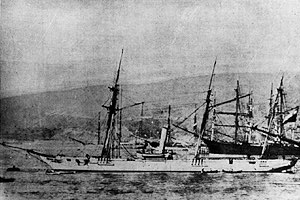
Huáscar is an ironclad turret ship owned by the Chilean Navy built in 1865 for the Peruvian government. It is named after the 16th-century Inca emperor, Huáscar. She was the flagship of the Peruvian Navy and participated in the Battle of Pacocha and the War of the Pacific of 1879–1883. At the Battle of Angamos, Huáscar, captained by renowned Peruvian naval officer Miguel Grau Seminario, was captured by the Chilean fleet and commissioned into the Chilean Navy.

The Battle of Angamos was a naval encounter of the War of the Pacific fought between the navies of Chile and Perú at Punta Angamos, on 8 October 1879. The battle was the culminating point of a naval campaign that lasted about five months in which the Chilean Navy had the sole mission of eliminating its Peruvian counterpart. In the struggle, two armored frigates, led by Commodore Galvarino Riveros Cárdenas and Navy Captain Juan José Latorre battered and later captured the Peruvian monitor Huáscar, under Rear Admiral Miguel Grau Seminario.

The Chilean Navy is the naval warfare service branch of the Chilean Armed Forces. It is under the Ministry of National Defense. Its headquarters are at Edificio Armada de Chile, Valparaiso.

Miguel María Grau Seminario was the most renowned Peruvian naval officer and hero of the naval battle of Angamos during the War of the Pacific (1879–1884). He was known as el Caballero de los Mares for his kind and chivalrous treatment of defeated enemies and is esteemed by both Peruvians and Chileans. He is an iconic figure for the Peruvian Navy, and one of the most famous merchant marine and naval military leaders of the Americas.

Agustín Arturo Prat Chacón was a Chilean lawyer and navy officer. He was killed in the Battle of Iquique, during the War of the Pacific.

The Naval Battle of Papudo was a naval engagement fought between Spanish and Chilean forces on November 26, 1865, during the Chincha Islands War. It was fought 55 miles north of Valparaiso, Chile, near the coastal town of Papudo.

The Battle of Punta Gruesa was a naval action that took place on May 21, 1879, during the War of the Pacific between Chile and Peru. This may be labelled as the second part of the Naval Battle of Iquique, although it is described in many sources as a separate battle.

Juan Williams Rebolledo, was a Chilean rear admiral who was the organizer and commander-in-chief of the Chilean navy in 1879 at the beginning of the War of the Pacific. As a politician, he was elected from Valparaiso to the national Congress in 1867, and in 1873 he was elected as city councillor.

Juan José Latorre Benavente Chilean Vice Admiral, one of the principal actors of the War of the Pacific, and hero of the Battle of Angamos.

The schooner Virgen de Covadonga was a ship that participated in the Chincha Islands War and the War of the Pacific, under Spanish and Chilean flags. She was launched in 1859. Covadonga hit a floating mine and sank off Chancay in 1880.

Luis Uribe Orrego was a Vice-Admiral of the Chilean Navy and a hero of the War of the Pacific.

Carlos Arnaldo Condell De La Haza was a Chilean naval officer and hero of the Battle of Punta Gruesa during the start of the War of the Pacific.

The Naval campaign of the War of the Pacific or Saltpeter war, was a naval campaign that took place from 1879 to 1884, involving Peru, and Chile, undertaken in order to support land forces in the Atacama Desert. Although the conflict lasted until 1884, the primary naval engagements occurred between 1879 and 1880. Due to the rough terrain and few transport methods it was imperative to have control of the ports in order to have a good supply source in the region. It resulted in a successful campaign by Chile, and the success of their land campaigns eventually led to a Chilean victory, which cut off Bolivia's access to the coast.

The Maritime history of Chile started when Chile gained independence, but traces it origin in the colonial era and has ultimately origin in the seafaring tradition of the Iberian Peninsula, Europe and the Mediterranean as well as from indigenous peoples of Chile.

Esmeralda was a wooden-hulled steam corvette of the Chilean Navy, launched in 1855, and sunk by the Peruvian ironclad Huáscar on 21 May 1879 at the Battle of Iquique during the War of the Pacific.

The Battle of Iquique was a naval engagement that occurred between a Chilean corvette under the command of Arturo Prat Chacón and a Peruvian ironclad under Miguel Grau Seminario on 21 May 1879, during the naval stage of the War of the Pacific, that pitted Chile against Peru and Bolivia. The battle took place off the then-Peruvian port of Iquique. The ironclad Huáscar sank the Chilean wooden corvette Esmeralda, after four hours of combat, resulting in a Peruvian victory.

Juan Bravo was a Chilean Navy sailor of mapuche origin, hero of the naval Battle of Punta Gruesa during the War of the Pacific. Juan Bravo distinguished himself in the Battle of Punta Gruesa where he while onboard of the schooner Covadonga sniped down numerous Peruvians on board of the ironclad Independencia.

The Chilean cruiser Esmeralda was the first protected cruiser, a ship type named for the arched armored deck that protected its most vital areas, including its propulsion plant and magazines.

The Naval Battle of Arica was a naval battle which took place on 27 February 1880 during the Blockade of Arica as part of the War of the Pacific.

The Raids of the Huáscar were a series of raids that occurred by the Peruvian ironclad Huáscar under the command of Miguel Grau Seminario during the War of the Pacific. The actions kept the Chilean government in check for nearly five months which ended after the Battle of Angamos.